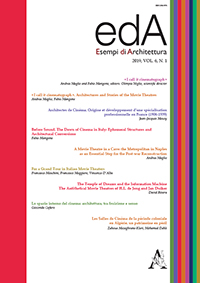Estratto da
ESEMPI DI ARCHITETTURA
International Journal of Architecture and Engineering
Architectes de cinéma. Origine et développement d’une spécialisation professionnelle en France (1906–1939)
ESEMPI DI ARCHITETTURA
International Journal of Architecture and Engineering
Architectes de cinéma. Origine et développement d’une spécialisation professionnelle en France (1906–1939)

The film architecture begins with the sedentary stage of this show, i.e. from 1906-1907 in France and in the economically developed countries. Although some architects made several cinemas before the First World War, it is difficult at this stage to talk about specialization. While the architects of the cinemas of the elegant neighbourhoods seek to attract the bourgeoisie by theatrical luxury, those of the poor neighbourhood cinemas, which undergo severe financial constraints on the part of their customers, are led to simplify, to streamline, or even standardize, their projects around a hangar architecture, usually with a street gable. The archetype of the latter is Georges Malo.
It was only after the First World War, in the years 1919-1922, that some architects begin to specialize in the construction of cinemas. Among them, Eugène Vergnes, who builds several "neighbourhood palaces" in the capital and its suburbs, is the first notable theorist of cinema architecture. Marcel Oudin also designs outstanding cinemas in Paris as well as in Clermont-Ferrand and Lyon. Henri Belloc works for the company Aubert during the same period, before building, in 1931, the new Gaumont Palace. Etc.
From 1929, the arrival of the sound cinema imposes severe technical constraints, in particular to avoid the excessive reverb of the rooms which would seriously harm the perception of sounds. The new invention awakens the French film industry and trade and propels a vast movement of building rooms, especially in the capital where their number increases by 81% between 1929 and 1939. While the influence "Art Deco" remains prevalent in the new establishments with notably Auguste Bluysen, Henri Belloc, Eugène Bruyneel, Eugène Chirié, Paul Dubreuil, Maurice Gridaine, a modernist movement begins to express itself in the architecture of cinemas with particularly Pierre de Montaut and Adrienne Gorska. The latter realize the most remarkable match between the architecture and the cinematographic function with the construction of all the news cinemas of the chain Cinéac in France. The two architects benefit from this rich experience when they design large cinemas such as the Normandie, on the Champs-Elysées.
It was only after the First World War, in the years 1919-1922, that some architects begin to specialize in the construction of cinemas. Among them, Eugène Vergnes, who builds several "neighbourhood palaces" in the capital and its suburbs, is the first notable theorist of cinema architecture. Marcel Oudin also designs outstanding cinemas in Paris as well as in Clermont-Ferrand and Lyon. Henri Belloc works for the company Aubert during the same period, before building, in 1931, the new Gaumont Palace. Etc.
From 1929, the arrival of the sound cinema imposes severe technical constraints, in particular to avoid the excessive reverb of the rooms which would seriously harm the perception of sounds. The new invention awakens the French film industry and trade and propels a vast movement of building rooms, especially in the capital where their number increases by 81% between 1929 and 1939. While the influence "Art Deco" remains prevalent in the new establishments with notably Auguste Bluysen, Henri Belloc, Eugène Bruyneel, Eugène Chirié, Paul Dubreuil, Maurice Gridaine, a modernist movement begins to express itself in the architecture of cinemas with particularly Pierre de Montaut and Adrienne Gorska. The latter realize the most remarkable match between the architecture and the cinematographic function with the construction of all the news cinemas of the chain Cinéac in France. The two architects benefit from this rich experience when they design large cinemas such as the Normandie, on the Champs-Elysées.
| pagine: | 10-29 |
| DOI: | 10.4399/97888255220442 |
| data pubblicazione: | Febbraio 2019 |
| editore: | Aracne |








